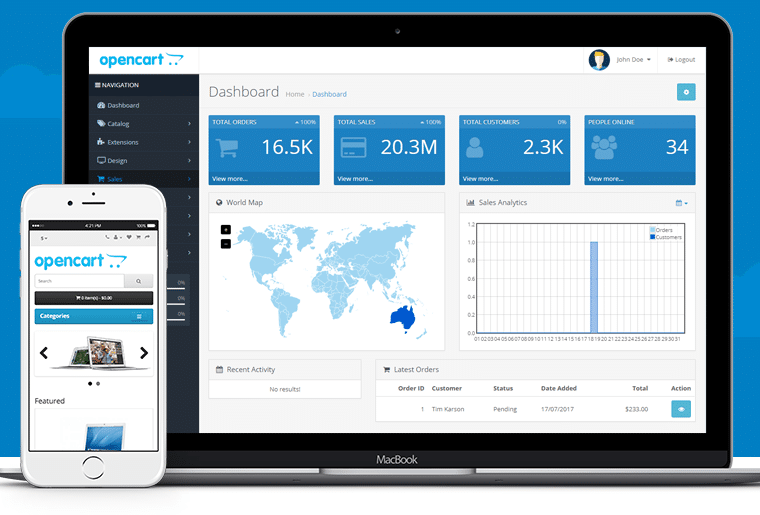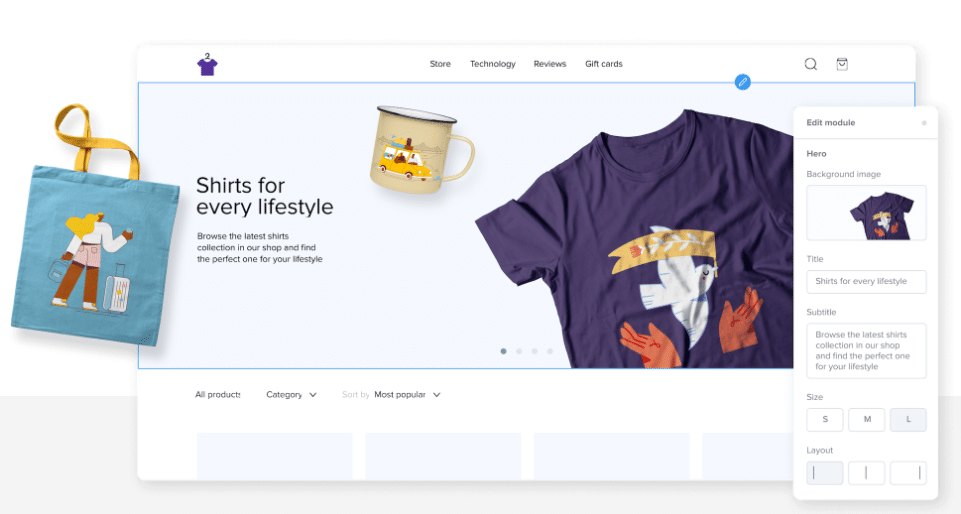The digital eCommerce universe has become one of the most competitive marketplaces around. According to Adobe, an estimated 26 million eCommerce websites are doing business today. If you’re looking to find your place under the sun, eCommerce platforms can help you achieve success in the digital marketplace.
If your business has tried an eCommerce website and failed, the problem might not be your brand or products. It might be the tools you used to build and maintain the virtual store. Today’s consumers are looking for more than just some nice product pictures and a blurb about the company.
They want to buy from websites that are easy to use and navigate. They look for key features such as search engines, chat customer service, options, and state-of-the-art security. According to Tech Jury, mobile buyers make up 67.2% of all online purchases, so they want responsiveness, too.
Setting up and managing a successful eCommerce website is a big hill to climb, but it is necessary. Brands must meet customers where they spend their time, and that is online. Ecommerce websites generated 856.8 billion dollars in revenue in 2022.
This article will discuss eCommerce platforms, their use, and why you need one.
A practical place to start is with a basic definition.
What Is An eCommerce platform?
An eCommerce platform is a system designed to make it easier for businesses to sell products to customers online. Unlike a traditional website, eCommerce platforms offer features like product listings, digital shopping carts, discount options, and more to create a comprehensive and engaging shopping experience. Put simply:
An eCommerce platform is software that facilitates the process of buying and selling goods and services online.
According to Tobias Lütke, co-founder and CEO of Shopify, “e-commerce is not an industry; e-commerce is a tactic.” So, the best eCommerce platforms allow owners to incorporate both marketing and sales to boost revenues and strengthen their bottom line.
What Does An eCommerce Platform Do?
It is responsible for coordinating the consumer’s relationship with the online seller.
If that all sounds vague, it’s because different eCommerce platforms offer additional features. At the basic level, this software will:
- Allow site users to search for products
- Provide a digital shopping cart
- Handle the payment process
Many platforms do much more than that, though. They might offer data analytics, for example. When shopping for an eCommerce platform, you need to find one that fits the company’s budget.
At the same time, it must offer the features necessary to allow your customers to order products and services seamlessly.
The Role of eCommerce Platforms in Your Business
Whether you’re running an online-only business or managing a brick-and-mortar operation, eCommerce platforms can enhance your company and make it easier to generate leads and sales.
One of the main advantages of using an eCommerce platform is that it incorporates everything necessary to sell products. Typically, these platforms allow you to:
- Manage and Update Product Inventory – Rather than having to count individual items manually, the platform will update inventory counts automatically with each sale. You can also update the system as you add more inventory or unique items.
- Handle Payments – One of the main advantages of using an eCommerce platform is that you can sell to anyone around the world. These platforms also enable you to use multiple payment options like PayPal, Stripe, credit cards, and more. Since these platforms are encrypted, you don’t have to worry as much about hackers.
- Order Fulfillment – Some eCommerce platforms enable you to take advantage of dropshipping, so you don’t have to manage inventory yourself. However, even if you make and ship each product, these platforms streamline the process by giving you everything from shipping labels to order tracking.
- Content Marketing – The best eCommerce platforms integrate with your marketing strategy for a seamless user experience. For example, a user clicks on a social media ad and lands on a product listing page. From there, they can order and pay for the product immediately, hassle-free.
Overall, eCommerce platforms enable you to scale your business online with minimal friction. Without these platforms, you would have to manage multiple third-party apps and programs to get the same results.
Key Features to Look for in an eCommerce Platform
Choosing the right eCommerce platform can be a challenge. Finding a platform that fits your business needs will allow you to:
- Control costs – This includes the set-up fees and any maintenance costs.
- Allow growth – Once the websites are up and running, the next step is to allow them to grow. Some platforms make that difficult or expensive.
- Enhance customer engagement – Many brands make this a primary focus because engagement can bring a customer back repeatedly.
- Prioritize customer service – Providing customer support means better conversions and enhanced loyalty.
What are some key features to look for on an eCommerce platform?
Hosting and platform type
There are two types of platforms: self-hosted and cloud-based. With a self-hosted or on-premise platform, you do much of the legwork. For example, you would need to find a host for the website, manage the installation, and do the administration.
That will give you more control but requires more time and technical knowledge. One person would be responsible for things like source coding and software updates.
A cloud-hosted platform means you work via the cloud. Cloud-based platforms can be further broken down as SaaS or PaaS. A SaaS platform such as Shopify is all-inclusive.
You simply pay for a website, provide the content, and choose a look for the site. You have access to additional apps, themes, and data analytics.
A PaaS cloud-based platform adds a hardware element. It falls between shared hosting and SaaS. The platform manages the operating system and software. You provide content, some code, and databases. A PaaS platform separates the business from the server administration.
The significant difference between the two is the coding. With SaaS, you don’t provide custom source code. It is more of a WYSIWYG option. PaaS gives you more control over the coding aspect.
Pricing
Pricing is an obvious consideration. You can expect most platforms to have a monthly fee. The exception to this might be open-source.
The cost varies from platform to platform and may differ based on the features you choose and how much bandwidth and storage you require.
Integrations
Businesses must think ahead when choosing a platform. What systems might you want to integrate with the eCommerce platform initially and in the future? Some options would include:
- Accounting
- Email marketing
- Shipping
- Payment
- Marketing
- Customer loyalty programs
Not all platforms allow for integrations.
Extensibility
A typical eCommerce platform provides the basis necessary to launch a website. They often come with ready-made integrations. You might need a more advanced PaaS platform if you want more than that.
Scalability
The other side of that coin is scalability. You want to be able to grow your website or scale it down during slower seasons.
Administration
How easy is it to add or delete products or establish inventory counts? What about changing prices? How do you upload images? You need to know how much effort it takes to make changes to your website.
Websites and eCommerce Platforms: What Sets Them Apart?
Ecommerce platforms and websites are terms sometimes used interchangeably, but they are quite different.
About an eCommerce platform
An eCommerce platform is a software-based platform that lets businesses sell products and services online. There are three main styles:
- Open-source – gives you complete access to the source codes and more control over how shopping is done through the site. Some examples of open-source platforms include Square Online, WooCommerce, and Joomla.
- SaaS is a cloud–based platform that is an all-in-one service. The platform handles everything; the business chooses a theme and provides the information. Examples of SaaS platforms include Shopify Plus and Salesforce Commerce Cloud.
- Headless – A headless platform separates the back end from the front end of customer-facing operations. You create the website using programs like WordPress or Drupal. The eCommerce platform provides cart and payment services. Examples of headless platforms include Spryker and BigCommerce.
That is different from an eCommerce website.
About an eCommerce website
An eCommerce website is any site with eCommerce features. In other words, any website where you can purchase something off it.
Many brands allow you to create an eCommerce website without the versatility of an eCommerce platform. They may offer a plug-in that serves as a payment gateway to allow for purchasing.
Having a basic website lacks the capabilities of an eCommerce platform, though. It won’t be scalable, for instance, or customizable. It will likely have very few features to choose from. The theme will be set in stone with no room for changes.
A simple website may be enough for small businesses with little online sales. For many companies, though, it will be too limiting.
Choosing the Right eCommerce Platform: Step by Step
With so many platforms available, it can be hard to determine which one is best for your business. Here are some critical points to consider before making a final decision.
Step One: Determine Your Product Lineup
Do you sell consumer packaged goods or clothing? Toys or accessories? Some platforms work well for certain industries, while others don’t. Ideally, you can pick a platform tailor-made for the types of products you’re selling. For example, if you sell items that can often be bundled with other products, you want a platform that makes bundling and accessorizing easier.
Another point to consider is whether you’ll work with drop shippers or handle inventory yourself. Drop-shipping can be useful, but you must work with high-quality vendors. Otherwise, customers may have to wait a long time for their orders, leading to lower satisfaction rates and reduced sales.
Step Two: Custom Building vs. Done-For-You (DFY)
If you have the time, you may want to build your eCommerce site from scratch, handling everything from product descriptions to page layouts. Alternatively, you can work with a platform that does everything for you. In the latter case, you just populate your pages with specific products, and the platform handles the rest.
If you’re a smaller operation, you may want to use a DFY platform and customize your pages over time. This way, you can get your site up and running sooner but still curate a unique value proposition as you go.
Step Three: Verify Security Practices
Since you’ll be handling online payments, you want a platform with excellent cybersecurity tools. Ideally, you won’t collect any customer data directly, so there’s no chance of its being hacked. Or, you can work with third-party payment providers like PayPal to add another layer of protection for yourself and your customers.
Step Four: Consider Scalability
When scaling your eCommerce platform, you must consider site traffic and product listings. Will you expand into new product lines in the future? If so, how easy is it to add more pages to your site? Similarly, if you’re increasing web traffic to your product listings, can the platform handle it? You don’t want your website to go down because too many people are shopping at once.
Step Five: Check Customer Support
Realistically, you’ll encounter problems or questions as you build your website. So, only work with an eCommerce platform that can help you with any issue, large or small. Ideally, the platform will have multiple customer support options, including email, live chat, and phone support. This way, you can resolve these issues immediately instead of waiting days for a response.
Top eCommerce Platforms in 2024: What Makes Them Stand Out?
For small and medium-sized businesses, the best eCommerce site is likely Shopify. Shopify is scalable and provides features that come in handy, although you might have to pay more for them.
Get to know more details about this platform and other 7 big players.
For instance, Shopify Fulfillment offers faster and more affordable shipping but comes at an added cost. Shopify has a number of these ala carte features. That allows businesses to pick and choose what they need instead of paying for something they won’t use.
1. Shopify
Unsurprisingly, the top tool on our list is Shopify.
This platform is a real one-stop-shop — excuse the pun! — for all things eCommerce.
Whether you are an eCommerce novice or know your way around eCommerce, Shopify is for you.
Super-easy to set up and configure, it allows you to both start a new eCommerce site from scratch as well as manage and maintain a well-established one.
Through Shopify, you can sell products from anywhere, including social media accounts, in-person sales, and third-party marketplaces.
How Much?
To begin with, you can try out Shopify for free for 14 days.
Then, if you are happy, you can choose one of its four plans: Basic Shopify ($14 per month), Shopify ($39 per month), Advanced Shopify ($299 per month), and Plus ($2,300).
What We Like Best
In this day and age, a huge — and ever-growing — amount of online sales are happening on mobile devices.
And guess what? Every Shopify theme is mobile-friendly. Not only that, but the platform also features tools like BuildFire which allow you to actually build separate Shopify mobile apps.
Pretty awesome, right?
2. Wix
You have probably heard of Wix as one of the most popular website builders.
And while this is, of course, true, this platform is also one of the best eCommerce tools out there.
With over 500 templates to choose from and no coding knowledge or experience required, you can build an amazing eCommerce site in literally a few clicks.
Wix makes it a cinch to create your own customizable digital storefront and shopping cart, as well as to add features including product galleries, mini-carts, and wishlists.
How Much?
A basic plan with Wix will cost you $17 a month, but you need to make sure that the specific subscription that you chose actually supports online sales.
If you want an intermediate eCommerce plan with Wix, then you are looking at prices that range from $29 to $36 per month.
A more advanced Wix plan is $159 per month.
What We Like Best
Wix is a really great choice for those who are just starting out in eCommerce, not only thanks to its ease of use and super-intuitive navigation but also because it supports dropshipping.
This means that it can allow you to browse through a huge catalog of products for sale, at no added cost.
3. Squarespace
Just like Wix, Squarespace is another very popular, very easy website builder.
But unlike Wix, every single one of its available business plans does come with in-built eCommerce capabilities.
The platform allows you to browse through an ever-expanding array of stunning templates that are particularly suited to businesses in creative industries.
But besides allowing you to showcase your amazing creative work, Squarespace also lets you sell it online.
How Much?
The Squarespace Personal plan costs $16 per month but doesn’t include any online selling capabilities.
At just a few more bucks — $23 per month, to be more precise — you’ll be able to have a fully integrated eCommerce site and sell as many products as you like, though still with some limitations.
If you are serious about selling on Squarespace, then your best bet is to pick either the Basic Commerce ($28 per month) or the Advanced Commerce ($52 per month) plan.
What We Like Best
Squarespace is truly one of the best eCommerce site builders in terms of aesthetics.
If you are aiming to display your products in a way that is eye-catching, professional, and enticing, then Squarespace is the way to go.
Plus, the platform is also integrated with other online selling tools, including PayPal, USPS, FedEx, Apple Pay, and Stripe.
4. WooCommerce
Here’s something a bit different from what we have seen so far: WooCommerce is not an actual eCommerce solution, it’s a plugin that you can add to your WordPress website.
Essentially, with WooCommerce you can add eCommerce capabilities to any WordPress site.
How Much?
More good news: this plugin is totally free to install.
However, you can also add some more extensions — some are free, while others have prices that go up to $5,000.
What We Like Best
The customization that this tool offers is truly fantastic.
Plus, WooCommerce also integrates with other online selling platforms like PayPal, Stripe, and Amazon Pay, making payments a real walk in the park.
5. BigCommerce
Another great eCommerce solution used by companies of all shapes and sizes in over 120 countries around the world, BigCommerce has pretty much everything you need to sell products online.
Established back in 2009, BigCommerce features unmatched eCommerce performance, including page loading speed, security, and uptime.
How Much?
BigCommerce offers four plans: Standard ($29 per month), Plus ($79 per month), Pro ($299 per month), and Enterprise (custom quotes for each user).
What We Like Best
BigCommerce is one of the few eCommerce tools that can support both individual online sales and B2B wholesales, thanks to its enterprise-ready eCommerce capabilities.
The platform also features amazing tools for SEO, conversions, inventory management, and 24/7 customer support.
6. Shift4Shop
If you thought that BigCommerce was one of the oldest eCommerce platforms out there, then think again: Shift4Shop beats it, as it was established in 1997.
While not suitable for beginner eCommerce marketers, Shift4Shop works well for more advanced eCommerce users.
This is because, unlike other solutions on our list, Shift4Shop is not as intuitive to use as other options in the market, but requires some coding and development knowledge.
How Much?
This platform offers five different payment plans. The cheapest costs only $29 per month, while the most expensive goes up to $229 per month for Standard plans (Enterprise can cost $2,000+).
Every plan offers a 30-day money-back guarantee in case you are not satisfied with your purchase.
Want to test the solution for free? 3DCart lets you play around with it for 15 days, at no cost.
What We Like Best
If you are comfortable with coding and development, then this is a great tool for you.
Once you have installed it, you’ll have access to over 200 eCommerce features, 50 free themes, and more than 100 payment providers.
You can also integrate 3DCart with third-party platforms such as Stripe, PayPal, Amazon, MailChimp, QuickBooks, and more.
7. OpenCart
This free, open-source tool brings eCommerce capabilities to already existing websites.
What this means, essentially, is that with the OpenCart plugin you can transform your standard site into an online store.
How Much?
OpenCart is free both to download and install, but if you require any extensions or more customized support, you will have to pay extra.
What We Like Best
We love OpenCart for its absolutely massive selection of themes and modules — 13,000, and counting — and the fact that you can integrate it with an equally huge list of payment and shipping providers.

8. BigCartel
While eCommerce platforms like Shopify or WooCommerce are great for physical products, what about artwork and graphic design? Big Cartel is perfect for artists or designers who want to sell their work without a complicated dashboard or backend system. This platform allows you to showcase fewer listings and focuses on highlighting your designs in real-world settings.
How Much?
Big Cartel has three pricing options:
- Gold – Free
- Platinum – $15/mo
- Diamond – $30/mo
You can start with a Gold plan and scale up as you add more listings and generate more leads. One of the primary advantages of upgrading is that you can get a custom domain name for your website (if necessary).
What We Like Best
Selling artwork or creative designs online can be challenging, especially if you use sites like Gumroad or RedBubble. Big Cartel gives you more creative control, so you can make your mark as an independent creator.
9. Adobe Commerce
Adobe is probably the largest creative design software company in the world, so if you use Adobe Commerce, you can tap into high-quality tools and materials that won’t be available anywhere else.
However, because it’s Adobe, you can also expect to pay more for the platform. We only recommend this option if you’re an established business with a decent marketing or operations budget. If you’re still new to the world of eCommerce, you may want to start with a more affordable platform and migrate to Adobe later.
How Much?
Adobe doesn’t list its pricing plans online, which often means they’re pretty expensive. Instead, you have to reach out to Adobe’s sales team to discuss options. There are two tiers: Commerce Pro and Managed Services. The latter is designed for enterprise-level businesses, so smaller companies need not apply.
What We Like Best
If you want the ultimate creative suite for building a unique eCommerce store, Adobe has everything you need. Building a website has never been easier, and Adobe’s generative AI software enables you to incorporate more elements than ever.
10. Sellfy
Digital products and print-on-demand are becoming far more popular. Traditional eCommerce platforms aren’t really suited to these product types, so you have to search elsewhere. Sellfy is fantastic because it caters to both POD and digital products, so you don’t have to use separate tools for each product type.
How Much?
Sellfy is a bit pricey if you pay monthly, but you can also take advantage of a free two-week trial to make sure it’ll work for your business. The pricing options are:
- Starter – $29/mo
- Business – $79/mo
- Premium – $159/mo
What We Like Best
Sellfy is very user-friendly, so even new entrepreneurs can get their eCommerce site up and running immediately. Also, because it’s designed for print-on-demand and digital products, it has tools to help you maximize your sales for these types of products.

11. Ecwid
Ecwid is the perfect solution for you when you already have a site without eCommerce capabilities and want to add them. Ecwid allows you to build an eCommerce platform on your existing website, so you don’t have to migrate everything to a different hosting service. Overall, this option is ideal for blogs or smaller, established companies that are just getting into the eCommerce space.
How Much?
You can start using Ecwid for free to see how well it integrates with your current website. From there, you can choose from three paid plans, including:
- Venture – $25/mo
- Business – $45/mo
- Unlimited – $105/mo
What We Like Best
It’s so easy to launch an eCommerce business from scratch with this platform. While it doesn’t have as many advanced tools and features, it’s perfect for smaller companies looking to branch out into new revenue streams.
A Final Advice
In the dynamic realm of e-commerce platforms, where every click counts, content creation emerges as the linchpin for success.
Engaging, informative content not only attracts customers but also fosters brand loyalty and drives conversions. As you embark on your journey into the digital marketplace, remember that quality content is the cornerstone of your online presence.
Elevate your e-commerce strategy with WriterAccess, where expert writers await to transform your ideas into captivating content.
Sign up for a free two-week trial today and witness firsthand the power of compelling storytelling in shaping your e-commerce success story.








